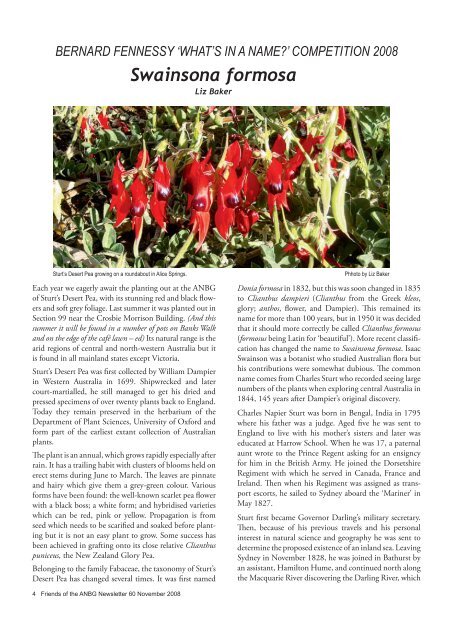51729 ANBG Friends NLetter - Friends of the Australian National ...
51729 ANBG Friends NLetter - Friends of the Australian National ...
51729 ANBG Friends NLetter - Friends of the Australian National ...
You also want an ePaper? Increase the reach of your titles
YUMPU automatically turns print PDFs into web optimized ePapers that Google loves.
BERNARD FENNESSY ‘WHAT’S IN A NAME?’ COMPETITION 2008<br />
4 <strong>Friends</strong> <strong>of</strong> <strong>the</strong> <strong>ANBG</strong> Newsletter 60 November 2008<br />
Swainsona formosa<br />
Liz Baker<br />
Sturt’s Desert Pea growing on a roundabout in Alice Springs. Phhoto by Liz Baker<br />
Each year we eagerly await <strong>the</strong> planting out at <strong>the</strong> <strong>ANBG</strong><br />
<strong>of</strong> Sturt’s Desert Pea, with its stunning red and black flowers<br />
and s<strong>of</strong>t grey foliage. Last summer it was planted out in<br />
Section 99 near <strong>the</strong> Crosbie Morrison Building. (And this<br />
summer it will be found in a number <strong>of</strong> pots on Banks Walk<br />
and on <strong>the</strong> edge <strong>of</strong> <strong>the</strong> café lawn – ed) Its natural range is <strong>the</strong><br />
arid regions <strong>of</strong> central and north-western Australia but it<br />
is found in all mainland states except Victoria.<br />
Sturt’s Desert Pea was first collected by William Dampier<br />
in Western Australia in 1699. Shipwrecked and later<br />
court-martialled, he still managed to get his dried and<br />
pressed specimens <strong>of</strong> over twenty plants back to England.<br />
Today <strong>the</strong>y remain preserved in <strong>the</strong> herbarium <strong>of</strong> <strong>the</strong><br />
Department <strong>of</strong> Plant Sciences, University <strong>of</strong> Oxford and<br />
form part <strong>of</strong> <strong>the</strong> earliest extant collection <strong>of</strong> <strong>Australian</strong><br />
plants.<br />
The plant is an annual, which grows rapidly especially after<br />
rain. It has a trailing habit with clusters <strong>of</strong> blooms held on<br />
erect stems during June to March. The leaves are pinnate<br />
and hairy which give <strong>the</strong>m a grey-green colour. Various<br />
forms have been found: <strong>the</strong> well-known scarlet pea flower<br />
with a black boss; a white form; and hybridised varieties<br />
which can be red, pink or yellow. Propagation is from<br />
seed which needs to be scarified and soaked before planting<br />
but it is not an easy plant to grow. Some success has<br />
been achieved in grafting onto its close relative Clianthus<br />
puniceus, <strong>the</strong> New Zealand Glory Pea.<br />
Belonging to <strong>the</strong> family Fabaceae, <strong>the</strong> taxonomy <strong>of</strong> Sturt’s<br />
Desert Pea has changed several times. It was first named<br />
Donia formosa in 1832, but this was soon changed in 1835<br />
to Clianthus dampieri (Clianthus from <strong>the</strong> Greek kleos,<br />
glory; anthos, flower, and Dampier). This remained its<br />
name for more than 100 years, but in 1950 it was decided<br />
that it should more correctly be called Clianthus formosus<br />
(formosus being Latin for ‘beautiful’). More recent classification<br />
has changed <strong>the</strong> name to Swainsona formosa. Isaac<br />
Swainson was a botanist who studied <strong>Australian</strong> flora but<br />
his contributions were somewhat dubious. The common<br />
name comes from Charles Sturt who recorded seeing large<br />
numbers <strong>of</strong> <strong>the</strong> plants when exploring central Australia in<br />
1844, 145 years after Dampier’s original discovery.<br />
Charles Napier Sturt was born in Bengal, India in 1795<br />
where his fa<strong>the</strong>r was a judge. Aged five he was sent to<br />
England to live with his mo<strong>the</strong>r’s sisters and later was<br />
educated at Harrow School. When he was 17, a paternal<br />
aunt wrote to <strong>the</strong> Prince Regent asking for an ensigncy<br />
for him in <strong>the</strong> British Army. He joined <strong>the</strong> Dorsetshire<br />
Regiment with which he served in Canada, France and<br />
Ireland. Then when his Regiment was assigned as transport<br />
escorts, he sailed to Sydney aboard <strong>the</strong> ‘Mariner’ in<br />
May 1827.<br />
Sturt first became Governor Darling’s military secretary.<br />
Then, because <strong>of</strong> his previous travels and his personal<br />
interest in natural science and geography he was sent to<br />
determine <strong>the</strong> proposed existence <strong>of</strong> an inland sea. Leaving<br />
Sydney in November 1828, he was joined in Bathurst by<br />
an assistant, Hamilton Hume, and continued north along<br />
<strong>the</strong> Macquarie River discovering <strong>the</strong> Darling River, which


